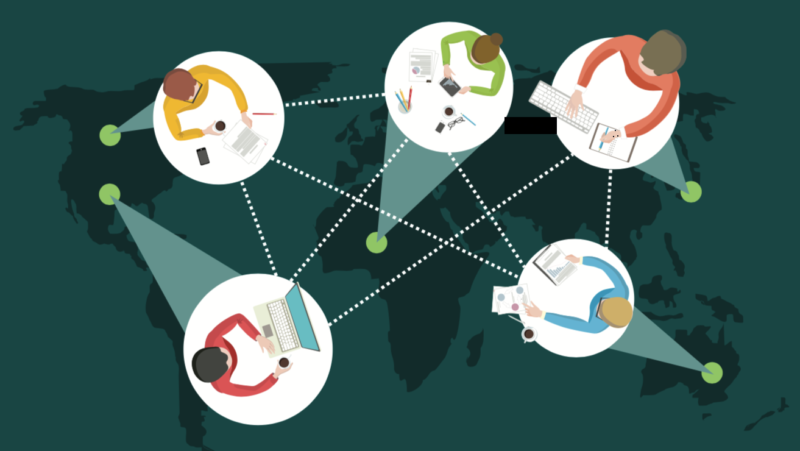A quick scan of job postings on LinkedIn and Indeed reflect the growing popularity and acceptance of remote work. Many, if not most, listings note in parentheses whether the opportunity is onsite, hybrid, or 100% remote. Search functions also let you filter listings using remote as a location.
Changes like these reflect the growing preferences of many employees and job seekers. And organizations with adaptable tools and mindsets have realized that remote work arrangements are key to attracting and retaining talent.
Just five years ago, these developments would have been unimaginable. But if predictions are correct, remote work isn’t going anywhere and will continue to reshape employer-employee relationships and professional environments. Here’s how.
1. Teams and Workers Will Become More Geographically Diverse
Remote work opens up the possibility of living anywhere with electricity and a reliable internet connection. Employees don’t have to be in the same city, state, or country as their employers. They can choose to set up shop in areas with lower housing and living expenses. Even if workers want to be near major cities, they can settle in more affordable suburbs without long commutes.
For employers, remote work arrangements mean they can hire from a wider pool of candidates. Instead of limiting recruitment efforts to a 50-mile radius from the corporate office, HR departments can scan the globe. So if your top candidate lives in Costa Rica and wants to stay there, it’s not an obstacle. Neither side has to walk away from a potentially beneficial professional relationship.
By establishing local entities or working with an employer of record service, companies can legally hire employees from other countries. According to Remote, EOR services also manage international payroll and benefits for organizations, ensuring that businesses remain compliant with local laws.

As technology and global employment services bridge distances between employers and employees, teams will become more diverse. They may represent a variety of cultures and geographical areas. Some staff members might even travel as they work, enriching the group’s perspective and expertise. Employers benefit from a wider range of talent, and employees enjoy more flexibility in where they work.
2. Centralized Knowledge Will Be More Critical
When colleagues work in person, they can share knowledge through face-to-face conversations and meetings. Employees absorb the company culture by observing how things get done, getting instant answers from managers, and interacting with others. A lot of procedures and conventions are verbally shared and communicated in real time.
You might find some of those processes and cultural aspects documented within a company’s employee manual or other resources. However, those documents rarely tell you everything you need to know to become an effective team player. It’s through repeated collaboration and synchronous coordination that you learn the ins and outs of your position, department, and organization.
Remote work removes most of that dynamic. Employees are no longer side by side and might be operating within different schedules and time zones. This means that colleagues often have to collaborate, share knowledge, and keep projects moving asynchronously (i.e., non-simultaneously). Written and centralized procedures, information, and cultural nuances become more crucial. So do technologies and platforms that allow for asynchronous communication.
Informal aspects of companywide and departmental knowledge will become formalized as a result. Staff will rely more on software and tools that document and exchange information within a single location. Many businesses are already using some of these platforms, including project management and collaboration software like Asana and Slack. However, the various capabilities of these apps will continue to merge and likely take center stage in more organizations.
3. More Companies Will Embrace Hybrid Work

McKinsey & Company reports that, post-pandemic, 53% of employees worldwide would prefer to work remotely at least three days a week. Among U.S. workers, that percentage is even higher: 63%. Another 17% of U.S. employees would like to work from home at least twice a week.
Some companies are already responding to these changing preferences by implementing hybrid work models. Under hybrid arrangements, staff members work remotely part-time and in the office the rest of the week. These work agreements are seen as the best of both worlds by employers and employees. Those who want to work in person five days a week can, and those who prefer more flexibility get it.
Hybrid work models also provide co-workers with some degree of person-to-person interaction. Employees may not feel as isolated from the organization or the team. They get enough face time with leadership and colleagues while enjoying the benefits of remote work. Staff may designate in-office days for collaboration sessions that are more difficult to do over Zoom. Then employees can power through assignments requiring more concentration on remote workdays.
Although some organizations have yet to formalize or plan hybrid work arrangements, more companies are expected to embrace them. McKinsey’s research also discovered nine out of 10 executives see hybrid work models being implemented in the future. Even if organizations don’t have all the details worked out yet, job seekers can look forward to more hybrid opportunities.
4. Performance Management and Metrics Will Evolve
Managers may find it easier to monitor performance when employees work in the office. They can simultaneously see and hear what staff members are working on. Managers can also pull people aside for private conversations or to provide instantaneous feedback. Remote work removes many of the visual and auditory cues leaders have come to rely on.

Supervisors might feel uncomfortable or uncertain about managing employee performance from afar. Consequently, performance management and metrics may look different because of remote and hybrid work. Hours spent on the job might become less important than the output itself.
Leaders will need to measure performance according to quality and how much work gets done. Managers may depend more on artificial intelligence and remote work tools to monitor productivity and communicate effectively. These tools could substitute for in-person, instant feedback and ensure managers’ and employees’ perspectives remain in sync.
Performance metrics may also expand to include employees’ wellness and job satisfaction. Remote workers tend to experience less separation between their personal and professional lives. This can be beneficial — or it can lead to burnout, disengagement, and turnover. To help prevent the latter, managers may need to incorporate employee engagement platforms and more holistic goals and measures.
Summary
Growing preferences for remote and hybrid work models continue to reshape the way organizations and employees function. Both sides can enjoy increased flexibility and a wider range of choices. However, the more significant changes will involve how companies and workers collaborate to achieve shared objectives. More inclusive ideas and perceptions about diversity, technology, and productivity will emerge to redefine what work means.









